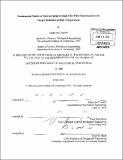| dc.contributor.advisor | Yang Shao-Horn. | en_US |
| dc.contributor.author | Crumlin, Ethan J | en_US |
| dc.contributor.other | Massachusetts Institute of Technology. Dept. of Mechanical Engineering. | en_US |
| dc.date.accessioned | 2012-11-19T19:17:05Z | |
| dc.date.available | 2012-11-19T19:17:05Z | |
| dc.date.copyright | 2012 | en_US |
| dc.date.issued | 2012 | en_US |
| dc.identifier.uri | http://hdl.handle.net/1721.1/74904 | |
| dc.description | Thesis (Ph. D.)--Massachusetts Institute of Technology, Dept. of Mechanical Engineering, 2012. | en_US |
| dc.description | Cataloged from PDF version of thesis. | en_US |
| dc.description | Includes bibliographical references. | en_US |
| dc.description.abstract | Searching for active and cost-effective catalysts for oxygen electrocatalysis is essential for the development of efficient clean electrochemical energy technologies. Perovskite oxides are active for surface oxygen exchange at evaluated temperatures and they are used commonly in solid oxide fuel cells (SOFC) or electrolyzers. However, the oxide surface chemistry at high temperatures and near ambient oxygen pressure is poorly understood, which limits the design of highly active catalysts. This work investigates heterostructured interfaces between (Lai. xSrx)CoO 3-3 (where x = 0.2 and 0.4, LSC80-2011 3 and LSC60-40 113 respectively) and (Lao. 5 Sro.5 )2CoO 4 ,3 (LSC2 14) enhanced ORR catalytic activity 1) via electrochemical impedance spectroscopy, atomic force microscopy, scanning electron microscopy, scanning transmission electron microscopy, and high resolution X-ray diffraction (HRXRD) and 2) using in situ ambient pressure X-ray photoelectron spectroscopy (APXPS) and in situ HRXRD. Here we show that the ORR of epitaxial LSC80-20 1 3 and LSC60-40113 is dramatically enhanced (~3-4 orders of magnitude above bulk LSC113) by surface decorations of LSC214 (LSC 1 31214) with coverage in the range from ~0.1 to ~15 nm. Such high surface oxygen kinetics (~ 110-5 cm-s1 at 550 C) are among the most active SOFC cathode materials reported to date. Although the mechanism for ORR enhancement is not yet fully understood, our results to date show that the observed ORR enhancement can be attributed to highly active interfacial LSCn 13/LSC214 regions, which were shown to be atomically sharp. Using in situ HRXRD and APXPS we show that epitaxial LSC80-20n3 thin films have lower coverage of surface secondary phases and higher Strontium enrichment in the perovskite structure, which is attributed to its markedly enhanced activity relative to LSC80-20113 powder. APXPS temperature cycling of epitaxial LSC80-20113 APXPS reveled upon heating to 520 *C the initial Sr enrichment which is irreversible, however subsequent temperature cycling demonstrates a small amount of reversible Sr enrichment. With applied potentials LSC80- 2013/214 shows significant Sr enrichment greater then LSC80-20 113, and the ability to stabilize high concentrations of both lattice and surface Sr which we hypothesize is a very important factor governing LSC80-2011 3214 enhanced ORR activity. | en_US |
| dc.description.statementofresponsibility | by Ethan Jon Crumlin. | en_US |
| dc.format.extent | 205 p. | en_US |
| dc.language.iso | eng | en_US |
| dc.publisher | Massachusetts Institute of Technology | en_US |
| dc.rights | M.I.T. theses are protected by
copyright. They may be viewed from this source for any purpose, but
reproduction or distribution in any format is prohibited without written
permission. See provided URL for inquiries about permission. | en_US |
| dc.rights.uri | http://dspace.mit.edu/handle/1721.1/7582 | en_US |
| dc.subject | Mechanical Engineering. | en_US |
| dc.title | Fundamental studies of heterostructured oxide thin film electrocatalysts for oxygen reduction at high temperatures | en_US |
| dc.type | Thesis | en_US |
| dc.description.degree | Ph.D. | en_US |
| dc.contributor.department | Massachusetts Institute of Technology. Department of Mechanical Engineering | |
| dc.identifier.oclc | 815429380 | en_US |
